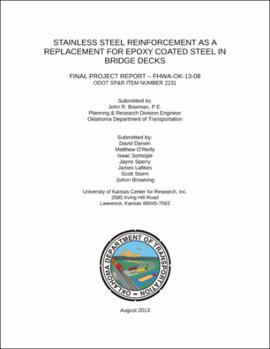| dc.creator | Darwin, David | |
| dc.creator | O'Reilly, Matthew | |
| dc.creator | Somogie, Isaac | |
| dc.creator | Sperry, Jayne | |
| dc.creator | Lafikes, James | |
| dc.creator | Storm, Scott | |
| dc.creator | Browning, JoAnn | |
| dc.date.accessioned | 2018-03-01T20:50:07Z | |
| dc.date.available | 2018-03-01T20:50:07Z | |
| dc.date.issued | 2013-8 | |
| dc.identifier.govdoc | FHWA-OK-13-08 | |
| dc.identifier.other | Oklahoma Department of Transportation State Planning and Research item number 2231 | |
| dc.identifier.uri | https://hdl.handle.net/11244/54448 | |
| dc.description.abstract | The corrosion resistance of 2304 stainless steel reinforcement and stainless steel clad reinforcement was compared to conventional and epoxy-coated reinforcement (ECR). 2304 stainless steel was tested in both the as-received condition (dark mottled finish) and repickled to a bright finish. Specimens were evaluated using rapid macrocell, Southern Exposure, and cracked beam tests. ECR and stainless steel clad specimens were evaluated with the coating having no intentional damage and with the coating or cladding penetrated. ECR with the coating penetrated is used to represent ECR that has undergone damage during construction. Clad bars were also bent to evaluate the corrosion resistance of the cladding after fabrication. Bars were tested for corrosion loss and chloride content at corrosion initiation. The critical chloride corrosion threshold for each system was established, as was an average corrosion rate after initiation. Results obtained from the southern exposure and cracked beam tests are used to the estimate cost effectiveness for each system under a 75-year and 100-year service life. Epoxy-coated reinforcement and stainless steel clad bars with and without intentional penetrations in the coating, as well as 2304 stainless steel in the as-received and repickled conditions exhibit a significant increase in corrosion resistance and critical chloride corrosion threshold compared to conventional steel, with undamaged epoxy-coated specimens exhibiting the lowest corrosion rate. In the as-received condition, 2304 stainless steel did not satisfy the requirements of ASTM A955, while repickled 2304 did. The undamaged stainless steel clad bars satisfied the requirements of the rapid macrocell test in ASTM A955; however, some cracked beam specimens containing stainless steel clad bars exhibited corrosion rates greater than the maximum allowable value permitted by ASTM A955. Conventional reinforcing steel is the least cost-effective form of reinforcement, with 2304 stainless steel in the as-received condition, ECR with penetrations through the epoxy, correctly pickled 2304 stainless steel, and stainless steel clad reinforcement representing progressively more cost-effective materials. Stainless steel clad reinforcement, however, is not currently available, and its failure to pass ASTM A955 calls its long-term performance into question. Increasing the cover over the top mat of steel and considering partial-deck replacements, where applicable, are methods that should be considered to decrease life cycle costs. | |
| dc.format.extent | 205 pages | |
| dc.format.extent | 9,285,583 bytes | |
| dc.format.medium | application.pdf | |
| dc.language | en_US | |
| dc.relation.ispartofseries | No | |
| dc.relation.requires | Adobe Acrobat Reader | |
| dc.relation.uri | http://citeseerx.ist.psu.edu/viewdoc/download?doi=10.1.1.691.1240&rep=rep1&type=pdf | |
| dc.title | STAINLESS STEEL REINFORCEMENT AS A REPLACEMENT FOR EPOXY COATED STEEL IN BRIDGE DECKS (FHWA-OK-13-08 2231) | |
| dc.type | Technical Report | |
| dc.description.version | Final Report, October 2010-July 2013 | |
| dc.description.peerreview | No | |
| dc.type.material | text | |
| dc.subject.keywords | Concrete | |
| dc.subject.keywords | chlorides (or critical chloride corrosion threshold) | |
| dc.subject.keywords | epoxy-coated reinforcement | |
| dc.subject.keywords | stainless steel | |
| dc.subject.keywords | stainless steel clad reinforcement | |
| dc.contributor.sponsor | Oklahoma Department of Transportation. Materials and Research Division. Office of Research & Implementation | |
